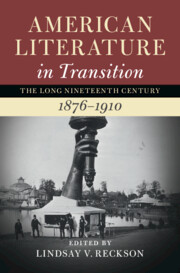Book contents
- American Literature in Transition, 1876–1910
- Nineteenth-Century American Literature in Transition
- American Literature in Transition, 1876–1910
- Copyright page
- Contents
- Contributors
- Series Preface
- Acknowledgments
- Chronology
- Introduction
- Part I Transitive States
- Chapter 1 Radical Pasts, Radical Futures
- Chapter 2 Unsettled Colonialisms
- Chapter 3 Secularism, Race, and Sex
- Chapter 4 Sex and the Suicide Plot
- Chapter 5 Virtual Subjects
- Part II Post-Reconstruction Aesthetics
- Part III Old Materialisms
- Part IV Immanent Techniques
- Index
Chapter 4 - Sex and the Suicide Plot
from Part I - Transitive States
Published online by Cambridge University Press: 24 August 2022
- American Literature in Transition, 1876–1910
- Nineteenth-Century American Literature in Transition
- American Literature in Transition, 1876–1910
- Copyright page
- Contents
- Contributors
- Series Preface
- Acknowledgments
- Chronology
- Introduction
- Part I Transitive States
- Chapter 1 Radical Pasts, Radical Futures
- Chapter 2 Unsettled Colonialisms
- Chapter 3 Secularism, Race, and Sex
- Chapter 4 Sex and the Suicide Plot
- Chapter 5 Virtual Subjects
- Part II Post-Reconstruction Aesthetics
- Part III Old Materialisms
- Part IV Immanent Techniques
- Index
Summary
At the turn of the century in the USA, when understandings of nation, person, and identity were in flux, the reassuring theoretical power of “modernity” and its vibrations of social progress were always troubled in practice, as much by the vicissitudes of political economy as by a host of interpenetrating forces of change and upheaval that can be said to characterize the experience of the modern world – forces of industry, empire, technology, war, massification, migration, and a rearticulated, brutalizing racism in the form of Jim Crow laws and the project of lynching. Within this context, how should literary critics approach the increased frequency of the suicide plot in American fiction? In many respects, the rise of the suicide plot during this period could be seen as a continuation of the nineteenth-century project of sentimentalism, encouraging sympathetic identification with minoritized characters. Or, perhaps, it could be said to reflect a growing sense of powerlessness against the instabilities and new aggressions of modern life. In this essay, I’d like to offer an alternative explanation of the function of the suicide plot by reading it in relation to shifts in forms of governance. In what follows, I will suggest that the suicide plot can be read not so much as an act of forfeiture or acquiescence to the difficulties of modern transition than as an aesthetic response to a newly complex and disciplinary environment, formulating a new kind of understanding of one’s relation to the terms of life.
- Type
- Chapter
- Information
- American Literature in Transition, 1876–1910 , pp. 78 - 91Publisher: Cambridge University PressPrint publication year: 2022

